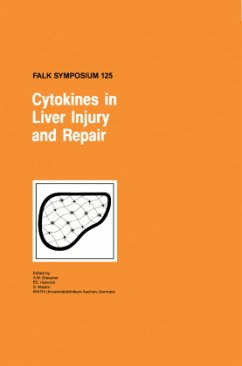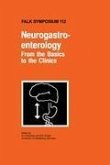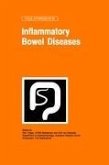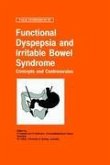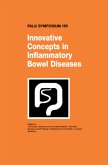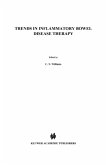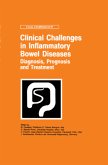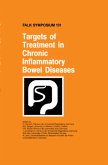Gressner
Cytokines in Liver Injury and Repair
Herausgegeben:Gressner, A. M.; Heinrich, P. C.; Matern, S.
Gressner
Cytokines in Liver Injury and Repair
Herausgegeben:Gressner, A. M.; Heinrich, P. C.; Matern, S.
- Gebundenes Buch
- Merkliste
- Auf die Merkliste
- Bewerten Bewerten
- Teilen
- Produkt teilen
- Produkterinnerung
- Produkterinnerung
This book, the proceedings of Falk Symposium No. 125 on 'Cytokines in Liver Injury and Repair' (Progress in Gastroenterology and Hepatology Part II), held in Hannover, Germany, on September 30 - October 1, 2001, provides an update of our current knowledge on the role of cytokines in various human and experimental liver diseases and on their present and prospective use in therapeutic trials.
The book contains chapters by most well-known experts in the field who have contributed significantly to our present knowledge on cytokines in liver injury and repair.
Andere Kunden interessierten sich auch für
![Neurogastroenterology - From the Basics to the Clinics Neurogastroenterology - From the Basics to the Clinics]() H.-J. Krammer / M.V. Singer (Hgg.)Neurogastroenterology - From the Basics to the Clinics242,99 €
H.-J. Krammer / M.V. Singer (Hgg.)Neurogastroenterology - From the Basics to the Clinics242,99 €![Inflammatory Bowel Diseases Inflammatory Bowel Diseases]() G.N. Tytgat / J.F.W.M. Bartelsman / S.J.H. van Deventer (Hgg.)Inflammatory Bowel Diseases242,99 €
G.N. Tytgat / J.F.W.M. Bartelsman / S.J.H. van Deventer (Hgg.)Inflammatory Bowel Diseases242,99 €![Functional Dyspepsia and Irritable Bowel Syndrome Functional Dyspepsia and Irritable Bowel Syndrome]() GoebellFunctional Dyspepsia and Irritable Bowel Syndrome121,99 €
GoebellFunctional Dyspepsia and Irritable Bowel Syndrome121,99 €![Innovative Concepts in Inflammatory Bowel Disease Innovative Concepts in Inflammatory Bowel Disease]() EmmrichInnovative Concepts in Inflammatory Bowel Disease161,99 €
EmmrichInnovative Concepts in Inflammatory Bowel Disease161,99 €![Trends in Inflammatory Bowel Disease Therapy Trends in Inflammatory Bowel Disease Therapy]() WilliamsTrends in Inflammatory Bowel Disease Therapy242,99 €
WilliamsTrends in Inflammatory Bowel Disease Therapy242,99 €![Clinical Challenges in Inflammatory Bowel Diseases Clinical Challenges in Inflammatory Bowel Diseases]() CampieriClinical Challenges in Inflammatory Bowel Diseases161,99 €
CampieriClinical Challenges in Inflammatory Bowel Diseases161,99 €![Targets of Treatment in Chronic Inflammatory Bowel Diseases Targets of Treatment in Chronic Inflammatory Bowel Diseases]() H. Herfarth / B.G. Feagan / U.R. Fölsch / J. Schölmerich / M.H. Vatn / M. Zeitz (Hgg.)Targets of Treatment in Chronic Inflammatory Bowel Diseases121,99 €
H. Herfarth / B.G. Feagan / U.R. Fölsch / J. Schölmerich / M.H. Vatn / M. Zeitz (Hgg.)Targets of Treatment in Chronic Inflammatory Bowel Diseases121,99 €-
-
-
This book, the proceedings of Falk Symposium No. 125 on 'Cytokines in Liver Injury and Repair' (Progress in Gastroenterology and Hepatology Part II), held in Hannover, Germany, on September 30 - October 1, 2001, provides an update of our current knowledge on the role of cytokines in various human and experimental liver diseases and on their present and prospective use in therapeutic trials.
The book contains chapters by most well-known experts in the field who have contributed significantly to our present knowledge on cytokines in liver injury and repair.
Hinweis: Dieser Artikel kann nur an eine deutsche Lieferadresse ausgeliefert werden.
The book contains chapters by most well-known experts in the field who have contributed significantly to our present knowledge on cytokines in liver injury and repair.
Hinweis: Dieser Artikel kann nur an eine deutsche Lieferadresse ausgeliefert werden.
Produktdetails
- Produktdetails
- Falk Symposium 125
- Verlag: Springer / Springer Netherlands
- Artikelnr. des Verlages: 978-0-7923-8775-6
- 2002
- Seitenzahl: 400
- Erscheinungstermin: 30. Juni 2002
- Englisch
- Abmessung: 241mm x 160mm x 29mm
- Gewicht: 833g
- ISBN-13: 9780792387756
- ISBN-10: 0792387759
- Artikelnr.: 22112485
- Herstellerkennzeichnung Die Herstellerinformationen sind derzeit nicht verfügbar.
- Falk Symposium 125
- Verlag: Springer / Springer Netherlands
- Artikelnr. des Verlages: 978-0-7923-8775-6
- 2002
- Seitenzahl: 400
- Erscheinungstermin: 30. Juni 2002
- Englisch
- Abmessung: 241mm x 160mm x 29mm
- Gewicht: 833g
- ISBN-13: 9780792387756
- ISBN-10: 0792387759
- Artikelnr.: 22112485
- Herstellerkennzeichnung Die Herstellerinformationen sind derzeit nicht verfügbar.
Preface. Section I: Cytokine-Induced Cell Death. 1. Endogenous modulators
of receptor-mediated hepatic cell death; H. Hentze, et al. 2. Modulation of
CD 95 (APO-1/Fas) induced hepatocyte death by NO; PR. Galle, et al. 3.
TGF-beta-induced liver cell apoptosis; R. Schulte-Hermann, et al. Section
II: Regulation of Normal and Malignant Cell Growth by Cytokines. 4.
Proliferative and apoptotic effects of tumour necrosis factor in the liver
and cells in culture; N. Fausto, J. Campbell. 5. The role of insulin-like
growth factor-II in hepatocarcinogenesis; P. Lund, et al. 6. Transforming
growth factor-beta and cancer; M. Reiss. 7. Cytokines and hepatitis C virus
replication; D. Moradpour, et al. Section III: Cytokine Signals in
Fibrogenesis. 8. Role of DDR2 receptor in the activation of hepatic
stellate cells; E. Olaso, et al. 9. PDGF signalling in activated stellate
cells; M. Pinzani. 10. Escape of activated hepatic stellate cells from
TGF-beta control; S. Dooley, et al. 11. Chemokines in the modulation of
liver inflammation; F. Marra, et al. Section IV: Modulation of Fibrogenic
Cytokine Response. 12. Identification of fibrogenic genes in a polygenic
mouse model of liver fibrosis; F. Lammert, et al. 13. Cytokine transgenic
models of fibrogenesis; S. Kanzler. 14. The fibrogenic mediators of
TGF-beta and TNF-alpha as surviving factors for activated hepatic stellate
cells; G. Ramadori, B. Saile. 15. Resolution of fibrosis by apoptosis of
myofibroblasts; F. Murphy, J.P. Iredale. Section V: Cytokines in the Cause
and Consequence of Cholestatis. 16. Regulation of hepatic organic anion
transporters by cytokines; A. Geier, et al. 17. Reaction of cholangiocytes
to inflammatory injury; C. Spirlì, et al. 18. Bid antisense
oligodeoxynucleotides as therapy for cholestatic liver injury; H. Higuchi,
G.J. Gores. Section VI: Polymorphisms of Cytokines and Signalling. 19.
Regulation of interleukin-6-type cytokine signaling; P.C. Heinrich, et al.
20. IL6-dependent signal transduction and its relevance in animal models;
K.L. Streetz, et al. 21. Predictive value of cytokine polymorphisms for
liver disease; P.T. Donaldson, C.P. Day. Section VII: Therapeutic Cytokines
and Modulators. 22. PPARγ and fibrogenesis; T. Miyahara, et al. 23.
Cytokine modulation in the therapy of hepatic immunopathology and fibrosis;
S.M. Wahl, et al. 24. Matrix binding motifs and peptide mimetics as
modulators of wound healing and fibrogenesis; D. Schuppan, et al. 25.
Endothelin and liver injury &endash; therapeutic antagonism of the
endothelin system; D.C. Rockey. 26. Transforming growth factor β in the
treatment of autoimmune disease; A.W. Lohse. Section VIII:
Cytokine-Assisted Gene Therapies. 27. The feasibility of antifibrotic gene
therapy; T.J. Davern, D.M. Bissell. 28. Experimental approaches to
antifibrotic strategies using gene transfer; R. Weiskirchen, et al. 29.
Cytokine-assisted gene therapy: Anti-TGF-β intervention using mutated forms
of TGF-β receptor; H. Ueno, et al. 30. Cytokine-based gene therapy of
hepatocellular carcinoma (HCC); C. Qian, et al. Index.
of receptor-mediated hepatic cell death; H. Hentze, et al. 2. Modulation of
CD 95 (APO-1/Fas) induced hepatocyte death by NO; PR. Galle, et al. 3.
TGF-beta-induced liver cell apoptosis; R. Schulte-Hermann, et al. Section
II: Regulation of Normal and Malignant Cell Growth by Cytokines. 4.
Proliferative and apoptotic effects of tumour necrosis factor in the liver
and cells in culture; N. Fausto, J. Campbell. 5. The role of insulin-like
growth factor-II in hepatocarcinogenesis; P. Lund, et al. 6. Transforming
growth factor-beta and cancer; M. Reiss. 7. Cytokines and hepatitis C virus
replication; D. Moradpour, et al. Section III: Cytokine Signals in
Fibrogenesis. 8. Role of DDR2 receptor in the activation of hepatic
stellate cells; E. Olaso, et al. 9. PDGF signalling in activated stellate
cells; M. Pinzani. 10. Escape of activated hepatic stellate cells from
TGF-beta control; S. Dooley, et al. 11. Chemokines in the modulation of
liver inflammation; F. Marra, et al. Section IV: Modulation of Fibrogenic
Cytokine Response. 12. Identification of fibrogenic genes in a polygenic
mouse model of liver fibrosis; F. Lammert, et al. 13. Cytokine transgenic
models of fibrogenesis; S. Kanzler. 14. The fibrogenic mediators of
TGF-beta and TNF-alpha as surviving factors for activated hepatic stellate
cells; G. Ramadori, B. Saile. 15. Resolution of fibrosis by apoptosis of
myofibroblasts; F. Murphy, J.P. Iredale. Section V: Cytokines in the Cause
and Consequence of Cholestatis. 16. Regulation of hepatic organic anion
transporters by cytokines; A. Geier, et al. 17. Reaction of cholangiocytes
to inflammatory injury; C. Spirlì, et al. 18. Bid antisense
oligodeoxynucleotides as therapy for cholestatic liver injury; H. Higuchi,
G.J. Gores. Section VI: Polymorphisms of Cytokines and Signalling. 19.
Regulation of interleukin-6-type cytokine signaling; P.C. Heinrich, et al.
20. IL6-dependent signal transduction and its relevance in animal models;
K.L. Streetz, et al. 21. Predictive value of cytokine polymorphisms for
liver disease; P.T. Donaldson, C.P. Day. Section VII: Therapeutic Cytokines
and Modulators. 22. PPARγ and fibrogenesis; T. Miyahara, et al. 23.
Cytokine modulation in the therapy of hepatic immunopathology and fibrosis;
S.M. Wahl, et al. 24. Matrix binding motifs and peptide mimetics as
modulators of wound healing and fibrogenesis; D. Schuppan, et al. 25.
Endothelin and liver injury &endash; therapeutic antagonism of the
endothelin system; D.C. Rockey. 26. Transforming growth factor β in the
treatment of autoimmune disease; A.W. Lohse. Section VIII:
Cytokine-Assisted Gene Therapies. 27. The feasibility of antifibrotic gene
therapy; T.J. Davern, D.M. Bissell. 28. Experimental approaches to
antifibrotic strategies using gene transfer; R. Weiskirchen, et al. 29.
Cytokine-assisted gene therapy: Anti-TGF-β intervention using mutated forms
of TGF-β receptor; H. Ueno, et al. 30. Cytokine-based gene therapy of
hepatocellular carcinoma (HCC); C. Qian, et al. Index.
Preface. Section I: Cytokine-Induced Cell Death. 1. Endogenous modulators
of receptor-mediated hepatic cell death; H. Hentze, et al. 2. Modulation of
CD 95 (APO-1/Fas) induced hepatocyte death by NO; PR. Galle, et al. 3.
TGF-beta-induced liver cell apoptosis; R. Schulte-Hermann, et al. Section
II: Regulation of Normal and Malignant Cell Growth by Cytokines. 4.
Proliferative and apoptotic effects of tumour necrosis factor in the liver
and cells in culture; N. Fausto, J. Campbell. 5. The role of insulin-like
growth factor-II in hepatocarcinogenesis; P. Lund, et al. 6. Transforming
growth factor-beta and cancer; M. Reiss. 7. Cytokines and hepatitis C virus
replication; D. Moradpour, et al. Section III: Cytokine Signals in
Fibrogenesis. 8. Role of DDR2 receptor in the activation of hepatic
stellate cells; E. Olaso, et al. 9. PDGF signalling in activated stellate
cells; M. Pinzani. 10. Escape of activated hepatic stellate cells from
TGF-beta control; S. Dooley, et al. 11. Chemokines in the modulation of
liver inflammation; F. Marra, et al. Section IV: Modulation of Fibrogenic
Cytokine Response. 12. Identification of fibrogenic genes in a polygenic
mouse model of liver fibrosis; F. Lammert, et al. 13. Cytokine transgenic
models of fibrogenesis; S. Kanzler. 14. The fibrogenic mediators of
TGF-beta and TNF-alpha as surviving factors for activated hepatic stellate
cells; G. Ramadori, B. Saile. 15. Resolution of fibrosis by apoptosis of
myofibroblasts; F. Murphy, J.P. Iredale. Section V: Cytokines in the Cause
and Consequence of Cholestatis. 16. Regulation of hepatic organic anion
transporters by cytokines; A. Geier, et al. 17. Reaction of cholangiocytes
to inflammatory injury; C. Spirlì, et al. 18. Bid antisense
oligodeoxynucleotides as therapy for cholestatic liver injury; H. Higuchi,
G.J. Gores. Section VI: Polymorphisms of Cytokines and Signalling. 19.
Regulation of interleukin-6-type cytokine signaling; P.C. Heinrich, et al.
20. IL6-dependent signal transduction and its relevance in animal models;
K.L. Streetz, et al. 21. Predictive value of cytokine polymorphisms for
liver disease; P.T. Donaldson, C.P. Day. Section VII: Therapeutic Cytokines
and Modulators. 22. PPARγ and fibrogenesis; T. Miyahara, et al. 23.
Cytokine modulation in the therapy of hepatic immunopathology and fibrosis;
S.M. Wahl, et al. 24. Matrix binding motifs and peptide mimetics as
modulators of wound healing and fibrogenesis; D. Schuppan, et al. 25.
Endothelin and liver injury &endash; therapeutic antagonism of the
endothelin system; D.C. Rockey. 26. Transforming growth factor β in the
treatment of autoimmune disease; A.W. Lohse. Section VIII:
Cytokine-Assisted Gene Therapies. 27. The feasibility of antifibrotic gene
therapy; T.J. Davern, D.M. Bissell. 28. Experimental approaches to
antifibrotic strategies using gene transfer; R. Weiskirchen, et al. 29.
Cytokine-assisted gene therapy: Anti-TGF-β intervention using mutated forms
of TGF-β receptor; H. Ueno, et al. 30. Cytokine-based gene therapy of
hepatocellular carcinoma (HCC); C. Qian, et al. Index.
of receptor-mediated hepatic cell death; H. Hentze, et al. 2. Modulation of
CD 95 (APO-1/Fas) induced hepatocyte death by NO; PR. Galle, et al. 3.
TGF-beta-induced liver cell apoptosis; R. Schulte-Hermann, et al. Section
II: Regulation of Normal and Malignant Cell Growth by Cytokines. 4.
Proliferative and apoptotic effects of tumour necrosis factor in the liver
and cells in culture; N. Fausto, J. Campbell. 5. The role of insulin-like
growth factor-II in hepatocarcinogenesis; P. Lund, et al. 6. Transforming
growth factor-beta and cancer; M. Reiss. 7. Cytokines and hepatitis C virus
replication; D. Moradpour, et al. Section III: Cytokine Signals in
Fibrogenesis. 8. Role of DDR2 receptor in the activation of hepatic
stellate cells; E. Olaso, et al. 9. PDGF signalling in activated stellate
cells; M. Pinzani. 10. Escape of activated hepatic stellate cells from
TGF-beta control; S. Dooley, et al. 11. Chemokines in the modulation of
liver inflammation; F. Marra, et al. Section IV: Modulation of Fibrogenic
Cytokine Response. 12. Identification of fibrogenic genes in a polygenic
mouse model of liver fibrosis; F. Lammert, et al. 13. Cytokine transgenic
models of fibrogenesis; S. Kanzler. 14. The fibrogenic mediators of
TGF-beta and TNF-alpha as surviving factors for activated hepatic stellate
cells; G. Ramadori, B. Saile. 15. Resolution of fibrosis by apoptosis of
myofibroblasts; F. Murphy, J.P. Iredale. Section V: Cytokines in the Cause
and Consequence of Cholestatis. 16. Regulation of hepatic organic anion
transporters by cytokines; A. Geier, et al. 17. Reaction of cholangiocytes
to inflammatory injury; C. Spirlì, et al. 18. Bid antisense
oligodeoxynucleotides as therapy for cholestatic liver injury; H. Higuchi,
G.J. Gores. Section VI: Polymorphisms of Cytokines and Signalling. 19.
Regulation of interleukin-6-type cytokine signaling; P.C. Heinrich, et al.
20. IL6-dependent signal transduction and its relevance in animal models;
K.L. Streetz, et al. 21. Predictive value of cytokine polymorphisms for
liver disease; P.T. Donaldson, C.P. Day. Section VII: Therapeutic Cytokines
and Modulators. 22. PPARγ and fibrogenesis; T. Miyahara, et al. 23.
Cytokine modulation in the therapy of hepatic immunopathology and fibrosis;
S.M. Wahl, et al. 24. Matrix binding motifs and peptide mimetics as
modulators of wound healing and fibrogenesis; D. Schuppan, et al. 25.
Endothelin and liver injury &endash; therapeutic antagonism of the
endothelin system; D.C. Rockey. 26. Transforming growth factor β in the
treatment of autoimmune disease; A.W. Lohse. Section VIII:
Cytokine-Assisted Gene Therapies. 27. The feasibility of antifibrotic gene
therapy; T.J. Davern, D.M. Bissell. 28. Experimental approaches to
antifibrotic strategies using gene transfer; R. Weiskirchen, et al. 29.
Cytokine-assisted gene therapy: Anti-TGF-β intervention using mutated forms
of TGF-β receptor; H. Ueno, et al. 30. Cytokine-based gene therapy of
hepatocellular carcinoma (HCC); C. Qian, et al. Index.

